Antarctica is a continent of extremes, and its birds are no exception. Antarctica has some of the most unique bird species in the world, adapted to survive in the harshest environment on earth.
From the iconic Emperor Penguin to the hardy South Georgia Pintail, Antarctica’s birds are adapted for the coldest climate on the planet.
This article will explore the fascinating birds of Antarctica and the adaptations that enable them to survive and thrive in this extreme environment.
49 Antarctica Birds
Antarctica is a continent of ice and snow, where the average temperature is below freezing, and the sun barely rises in winter. Yet, despite these harsh conditions, Antarctica is home to 49 species of birds that have adapted to this extreme environment. Here are 49 Antarctica Birds:
1. Penguins
Penguins are an amazing species of aquatic birds that live mainly in the Southern Hemisphere. They have a unique plumage, black and white counter-shaded to aid them while swimming in the water.
Penguins feed mostly on krill, small crustaceans found near Antarctica. These remarkable creatures can’t fly, but they compensate by being excellent swimmers due to their flippers-like wings, which help them move faster underwater.
All this makes penguins one of nature’s most fascinating animals – not just for kids.
Scientific classification:
| Kingdom | Animalia |
| Phylum | Chordata |
| Class | Aves |
| Clade | Austrodyptornithes |
| Order | Sphenisciformes Sharpe, 1891 |
| Family | Spheniscidae Bonaparte, 1831 |
Also Featured In: Birds You’ll Find in the Sea, Famous Paintings Birds
2. Wandering Albatross
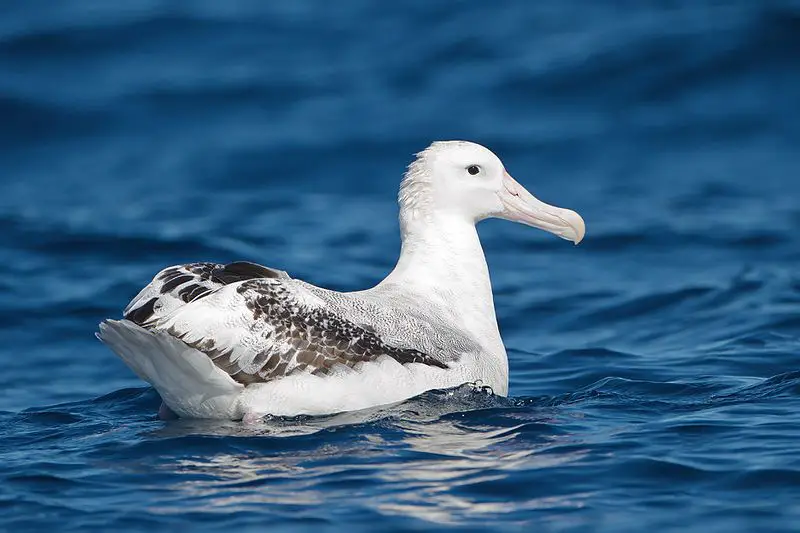
The Wandering Albatross is a large seabird from the family Diomedeidae found in the Southern Ocean. It has white wings, black tips, and a long hooked bill.
With an impressive wingspan of up to 3m, they are one of the largest birds that can fly.
They spend most of their lives far out at sea, only coming to land for the breeding season on remote islands where they nest on cliffs or rocky areas close to the ocean.
The species was first described in 1783 but had been considered similar to other albatrosses, such as Tristan Albatross and Antipodean Albatross, until recently when it was recognized as an individual species due to genetic studies showing differences.
Scientific classification:
| Kingdom | Animalia |
| Phylum | Chordata |
| Class | Aves |
| Order | Procellariiformes |
| Family | Diomedeidae |
| Genus | Diomedea |
| Species | D. exulans |
Also Featured In: Flight Birds You Should Know, Birds that Live in the Ocean
3. Skuas
Skuas are a group of predatory seabirds with seven species belonging to the genus Stercorarius.
They are also known as “Jaegers” in North America, and their name originates from the Faroese word for Great Skua – skúgvur.
These birds typically inhabit coastal areas or open oceans where they feed on fish, krill, and other marine creatures.
Skuas can be distinguished by their pointed wings, which help them fly long distances while hunting food.
Their distinctive coloration varies depending on age and habitat but generally includes greyish brown upperparts and white underparts with black streaks along their belly area.
The overall size ranges from 24-40 cm, making this one of the larger seabird species.
Scientific classification:
| Kingdom | Animalia |
| Phylum | Chordata |
| Class | Aves |
| Order | Charadriiformes |
| Suborder | Lari |
| Family | Stercorariidae Gray, 1871 |
| Genus | Stercorarius Brisson, 1760 |
4. Snow Petrel
The snow petrel (Pagodroma nivea) is a unique bird, the only member of its genus. It can be seen at the Geographic South Pole alongside two other species – Antarctic Petrel and south polar skua – which also breed in Antarctica’s most southerly locations.
This was first noticed in 1777 by German naturalist Georg Forster during his voyage around the world; he described it in detail on his return.
The Snow Petrel has white plumage with dark markings, black legs, feet, and a pink bill, typically found near ice-covered seas or coastal waters.
Their diet consists mainly of krill, but they will also take crustaceans and small fish when available. They nest amongst rocks close to their feeding grounds, adapting them to life in this harsh environment.
Scientific classification:
| Kingdom | Animalia |
| Phylum | Chordata |
| Class | Aves |
| Order | Procellariiformes |
| Family | Procellariidae |
| Genus | Pagodroma Bonaparte, 1856 |
| Species | P. nivea |
5. Emperor Penguin
The Emperor penguin is an amazing bird – the tallest and heaviest living penguin. It has a unique plumage with black head and back feathers sharply contrasted against its white belly, pale-yellow breast, and bright-yellow ear patches.
It’s a sight to behold, reaching up to 100 cm in length and weighing 22–45 kg.
The Emperor Penguin is endemic to Antarctica, where they feed on krill fish or squid, depending on the season. Breeding occurs during the harsh winter when temperatures drop as low as −40 °C (−40 °F).
Despite this extreme climate, their remarkable adaptations allow them to survive in these unforgiving conditions – making them one of nature’s true marvels.
Scientific classification:
| Kingdom | Animalia |
| Phylum | Chordata |
| Class | Aves |
| Order | Sphenisciformes |
| Family | Spheniscidae |
| Genus | Aptenodytes |
| Species | A. forsteri |
Also Featured In: Tundra Birds,
6. South Polar Skua
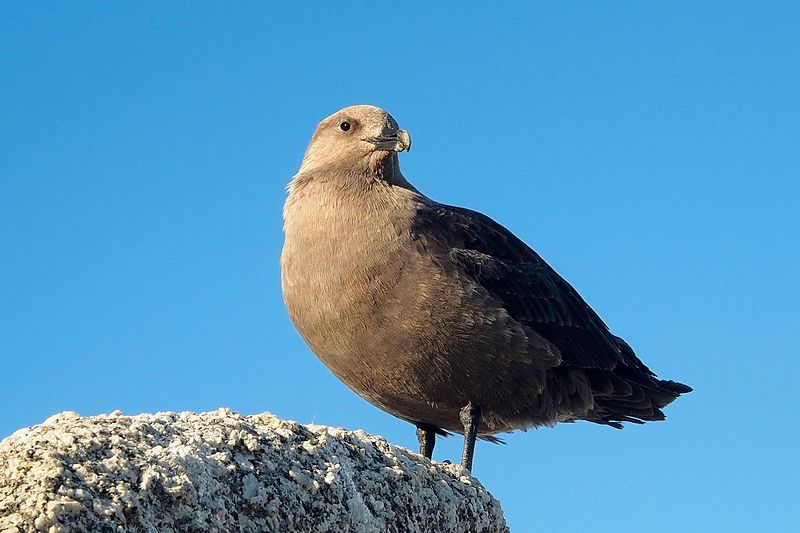
The South Polar Skua is a large seabird of the Stercorariidae family, also known as MacCormick’s Skua after explorer and naval surgeon Robert McCormick.
It has an impressive wingspan of up to 110 cm and can weigh up to 1 kg.
It loves cold climates such as Antarctica or Southern Ocean islands, where it breeds on rocky slopes in the summer months.
These birds feed mainly on fish they catch by plunge-diving from mid-air into the ocean surface; they will even scavenge food scraps left behind by other sea creatures.
The South Polar Skua is classified as “Near Threatened” due to its decreasing population numbers over recent years, primarily caused by human activity such as fishing practices and climate change.
Scientific classification:
| Kingdom | Animalia |
| Phylum | Chordata |
| Class | Aves |
| Order | Charadriiformes |
| Family | Stercorariidae |
| Genus | Stercorarius |
| Species | S. maccormicki |
7. Giant Petrel
Giant petrels are large seabirds belonging to the Procellariidae family and form two species known as Macronectes.
They inhabit mainly the Southern Hemisphere with overlapping distributions of breeding grounds such as the Prince Edward Islands, Crozet Islands, Kerguelen Islands, Macquarie Island, and South Georgia.
These birds have an impressive wingspan that can reach up to 1m long, and they feed on carrion or scavenge for food at sea or near shorelines.
Their size makes them capable predators who will fight off other animals during mealtime if necessary.
Giant petrels are solitary creatures, but when mating season comes around, they join together in colonies, making quite a spectacle across their range of territories.
Scientific classification:
| Kingdom | Animalia |
| Phylum | Chordata |
| Class | Aves |
| Order | Procellariiformes |
| Family | Procellariidae |
| Genus | Macronectes Richmond, 1905 |
8. Antarctic Petrel
The Antarctic petrel is a dark brown and white boldly marked petrel, found mainly in the Ross and Weddell Seas of Antarctica.
While swimming, it feeds on krill, fish, and small squid but can dive from the surface or air.
Captain James Cook first saw the bird during his second voyage to the South Pacific in 1773.
These birds have strong wings, which allow them to stay aloft for long periods whilst searching for food over vast distances.
They are incredibly social creatures that travel together in large flocks when not breeding season; however, they become very territorial regarding nesting sites, where they will fiercely defend their territory against intruders.
Scientific classification:
| Kingdom | Animalia |
| Phylum | Chordata |
| Class | Aves |
| Order | Procellariiformes |
| Family | Procellariidae |
| Genus | Thalassoica Reichenbach, 1853 |
| Species | T. antarctica |
9. Southern Giant Petrel
The Southern giant petrel is a large seabird native to the southern oceans, and it overlaps broadly with its similar counterpart, the Northern giant petrel.
Adults of both species can be distinguished by their bill-tip color: greenish in the south and yellowish in the north.
The Southern giant petrel also goes by other names such as Antarctic giant petrel, Giant fulmar, Stinker, or Stinkpot.
These birds are around 75 cm (30 inches) long on average and have striking white plumage combined with brown wings that give them an impressive appearance while they soar through skies above open waters searching for food like fish, krill, and squid – which they can catch up to 100 meters below sea level.
Scientific classification:
| Kingdom | Animalia |
| Phylum | Chordata |
| Class | Aves |
| Order | Procellariiformes |
| Family | Procellariidae |
| Genus | Macronectes |
| Species | M. giganteus |
10. Black-Browed Albatross
The Black-browed Albatross is a majestic seabird that belongs to the albatross family known as Diomedeidae.
It is an impressive bird, with its black beak and brow contrasting against the white plumage on its wings and body.
The most widespread member of this group, it can often be seen flying around oceans in different parts of the world.
These birds share many features with other members of their order Procellariiformes, such as shearwaters, fulmars, storm petrels, and diving petrels; they all have long wingspans for gliding effortlessly above water surfaces.
They feed mainly by scavenging or hunting small fish near the sea surface while flying low over the waters.
Its population has unfortunately declined due to commercial fishing vessels, which attract them closer to shore, entangling fishing nets and leading them towards mortality.
Scientific classification:
| Kingdom | Animalia |
| Phylum | Chordata |
| Class | Aves |
| Order | Procellariiformes |
| Family | Diomedeidae |
| Genus | Thalassarche |
| Species | T. melanophris |
Also Featured In: Most Common Birds in South America Birds, Patagonia Birds You Should Know
11. Antarctic Tern
The Antarctic tern is a seabird in the Laridae family. It inhabits southern oceans and small islands around Antarctica and mainland coasts.
This stocky bird has similar features to its relative Arctic Tern but can be identified by its breeding plumage of white feathers with black markings on the head, wings, and tail.
Its diet mainly consists of fish, crustaceans, and other marine animals, which it catches during dives or hovering over the water’s surface.
The Antarctic terns breed between October and March when they congregate near coastal areas where they can find plenty of food for themselves and their young ones.
These birds make impressive long-distance travels each year back to the same locations, making them true ocean wanderers.
Scientific classification:
| Kingdom | Animalia |
| Phylum | Chordata |
| Class | Aves |
| Order | Charadriiformes |
| Family | Laridae |
| Genus | Sterna |
| Species | S. vittata |
Also Featured In: South Shetland Islands Birds You Need To Know, Birds That Live In Heard Island and McDonald Islands
12. Southern Fulmar
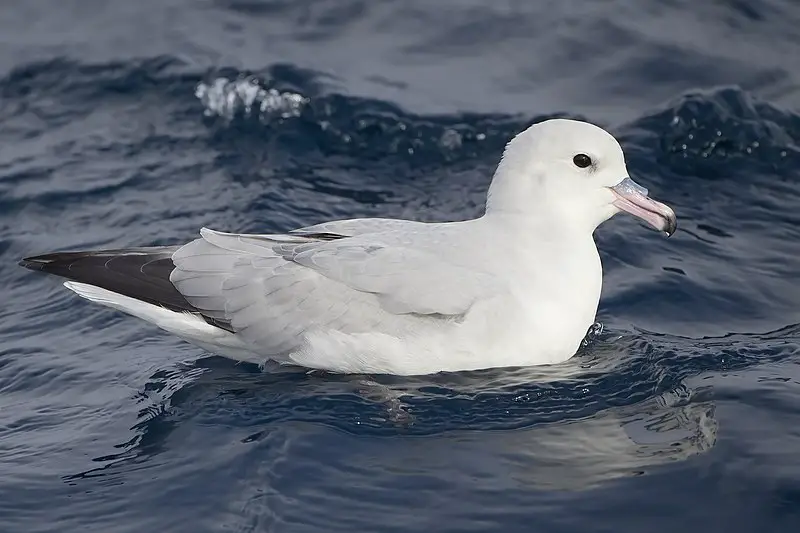
The Southern fulmar is a species of seabird found in the southern hemisphere. It has an overall pale grey body and white underparts, with a unique white patch on the wings.
Its breeding season occurs mainly along coastlines, where it builds its nest to lay eggs.
These birds are often seen soaring through the skies or bobbing atop waves near coasts during their migration periods as they search for food, which includes fish, squid, crustaceans, and other marine creatures.
Their diet also consists of carrion, such as dead seals or whales floating at sea that are scavenged upon by these opportunistic omnivores.
With increasing concern over environmental protection and conservation efforts for oceanic wildlife habitats worldwide, this remarkable species will no doubt continue to play an important role in maintaining balance within our fragile ecosystems across the globe.
Scientific classification:
| Kingdom | Animalia |
| Phylum | Chordata |
| Class | Aves |
| Order | Procellariiformes |
| Family | Procellariidae |
| Genus | Fulmarus |
| Species | F. glacialoides |
Also Featured In: Common Birds that Live around Ushuaia, Most Common Birds in Stewart Island
13. King Penguin
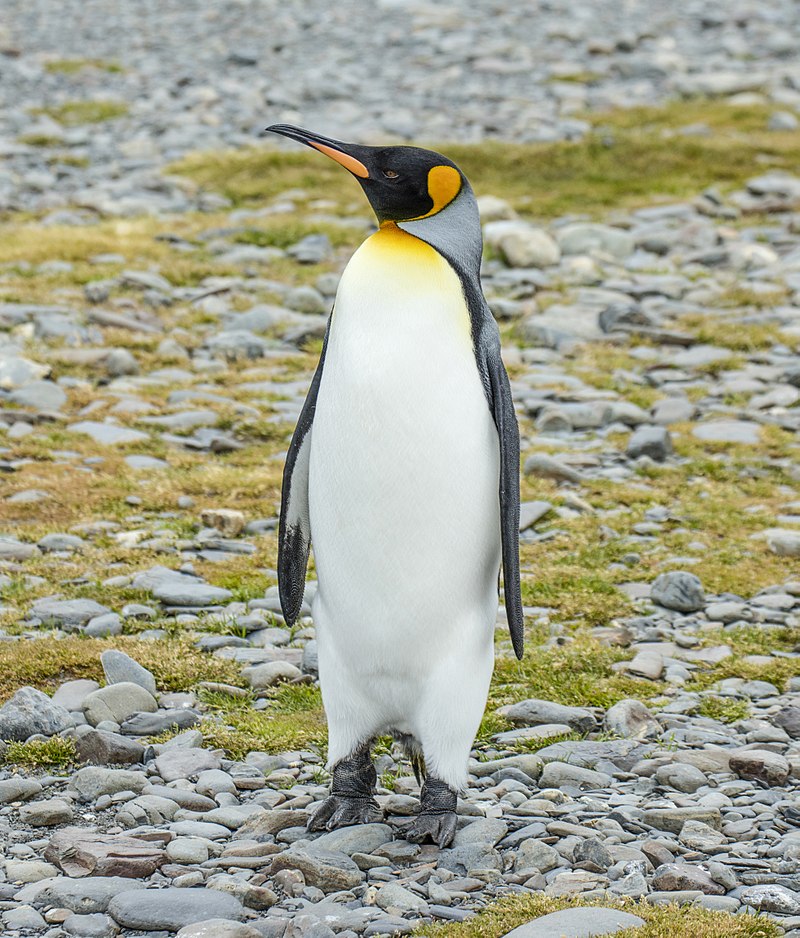
King penguins are majestic birds that live in the temperate and sub-Antarctic regions of the South Atlantic and Indian Oceans.
They stand up to 3 feet tall, making them smaller than their relative, the Emperor Penguin.
King Penguins have distinctive two-toned orange and black plumage with white markings on their faces around their eyes, which gives them an elegant look.
Unlike other penguin species, they don’t migrate as much but stay close to breeding grounds year-round, living off fish and squid near shorelines or ice floes.
Their diet also consists of krill shrimp, small crustaceans such as copepods or amphipods eaten whole, and occasional planktonic organisms like jellyfish for variety.
King Penguins form large colonies where males participate in incubation duties while females feed at sea for weeks during mating season.
Scientific classification:
| Kingdom | Animalia |
| Phylum | Chordata |
| Class | Aves |
| Order | Sphenisciformes |
| Family | Spheniscidae |
| Genus | Aptenodytes |
| Species | A. patagonicus |
Also Featured In: Falkland Islands Birds You Need To Know, Birds That Live around East Falkland
14. Brown Skua
The brown skua is a large seabird found in subantarctic and Antarctic regions, often moving further north to find food when not breeding.
It has many names, including the Antarctic Skua, Southern Great Skua, or Hākoakoa (Māori).
Its taxonomy has been disputed, with some believing it should be split into two or three species like Falkland Skuas.
The Brown Skuas are mostly dark grey-brown on top with white bellies and have long wings that enable them to fly great distances over vast oceans searching for food.
They feed mainly on fish but also scavenge from other animals’ kills, such as penguins and petrels.
In their natural environment, they form strong social bonds which help protect their young ones against predators while nesting near colonies of birds in the grasslands surrounding Antarctica’s coasts.
Scientific classification:
| Kingdom | Animalia |
| Phylum | Chordata |
| Class | Aves |
| Order | Charadriiformes |
| Family | Stercorariidae |
| Genus | Stercorarius |
| Species | S. antarcticus |
Also Featured In: Common Birds Found near Saint Helena,
15. Adélie Penguin
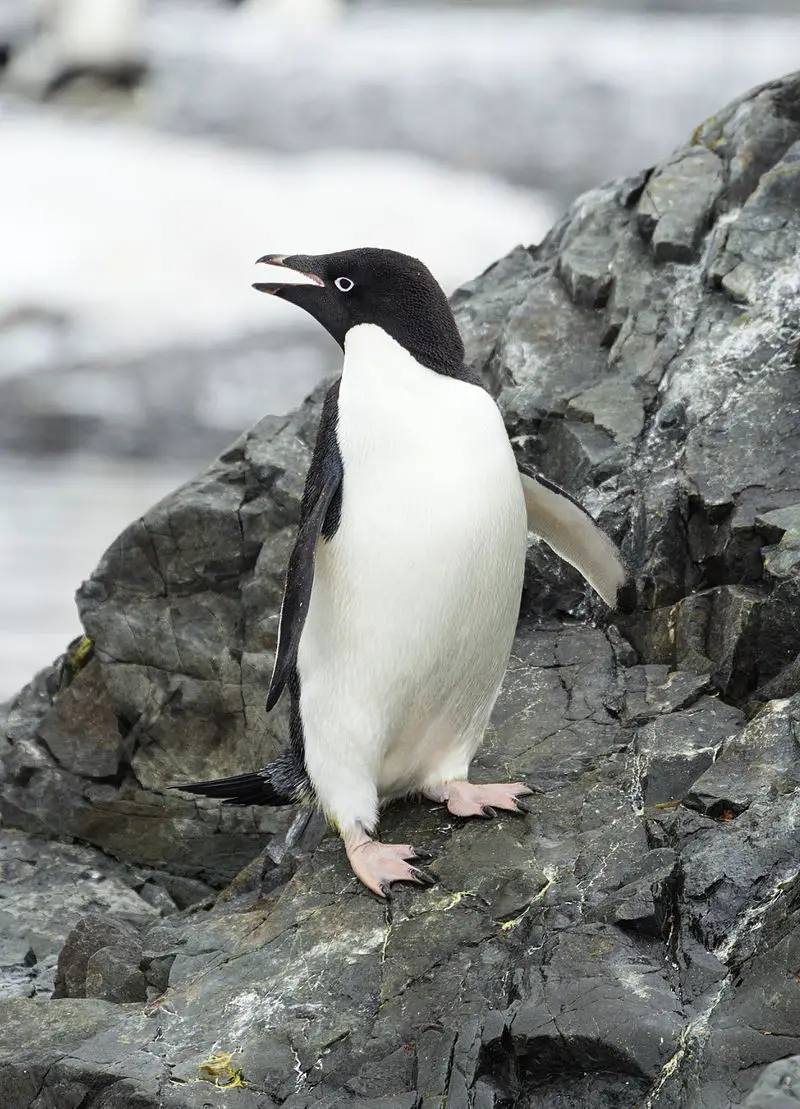
The Adélie penguin is a species of bird unique to the Antarctic continent. It’s one of the most widespread and southerly distributed penguins, and its name comes from Adéle Dumont d’Urville – wife of French explorer Jules Sébastian César Dumont d’Urville who explored much of Antarctica in 1837-1840.
They’re well adapted for life on land as they have thick layers of feathers that insulate them against cold temperatures, webbed feet used for swimming great distances & strong beaks made for catching fish like krill & squid.
Their diet also includes crustaceans, mollusks, and cephalopods, plentiful around Antarctica’s coastlines, nesting in large colonies during the breeding season.
Scientific classification:
| Kingdom | Animalia |
| Phylum | Chordata |
| Class | Aves |
| Order | Sphenisciformes |
| Family | Spheniscidae |
| Genus | Pygoscelis |
| Species | P. adeliae |
Also Featured In: Common Birds of Weddell Island,
16. Kelp Gull
The Kelp Gull is a majestic bird found on coasts and islands of the Southern Hemisphere. It has a beautiful plumage of black, white, and grey feathers and brown eyes.
Its wingspan ranges between 91-122 cm (36 – 48 inches). The nominate L. d. Dominican subspecies is most commonly seen around South America, parts of Australia, and New Zealand, where it goes by the name “black-backed gull” or “mohawk.”
These birds are omnivorous but prefer fish as their primary food source, while they also scavenge carrion when necessary.
To stand out from other seagulls during mating season, they display vibrant courtship rituals, which involve flying high in circles over their nesting area and flapping their wings dramatically before diving into the water near potential mates.
Scientific classification:
| Kingdom | Animalia |
| Phylum | Chordata |
| Class | Aves |
| Order | Charadriiformes |
| Family | Laridae |
| Genus | Larus |
| Species | L. dominicanus |
17. Cape Petrel
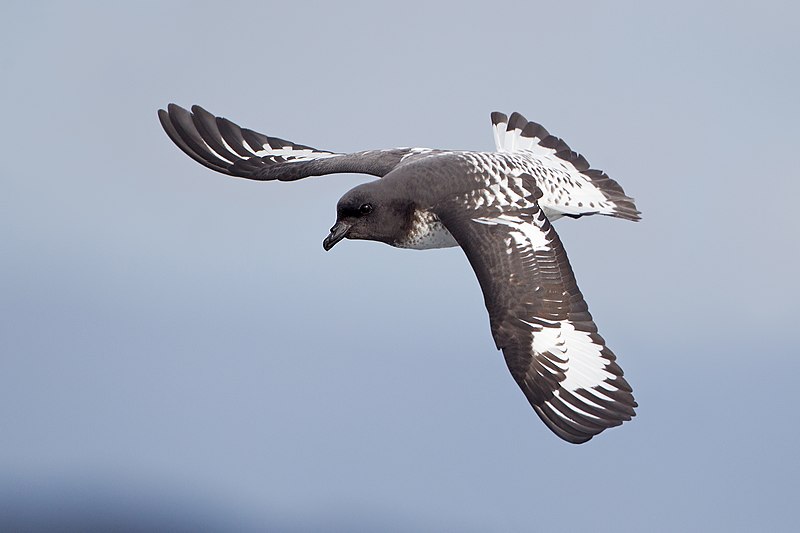
The Cape petrel is a seabird from the Procellariidae family that lives in the Southern Ocean. It is the only species of its genus with many allies, including fulmarine and giant petrels.
This species is abundant, with an estimated population of around two million individuals. Its plumage consists mainly of dark grey on top and white underneath, making it easily identifiable when flying overhead or perched atop rocks along shorelines.
They usually feed at night while searching for fish, crustaceans, squid, and other marine life near surface waters, using their strong sense of smell to find prey in low-light conditions.
Cape Petrels often gather into large flocks as they migrate between Antarctic seas during winter months before returning home to breed during summertime. They form large colonies along coastlines throughout southern oceans, such as New Zealand’s South Island coasts.
Scientific classification:
| Kingdom | Animalia |
| Phylum | Chordata |
| Class | Aves |
| Order | Procellariiformes |
| Family | Procellariidae |
| Genus | Daption Stephens, 1826 |
| Species | D. capense |
Also Featured In: Most Common Birds of Sierra Islands, Welcome Islands Birds You Need To Know
18. Wilson’s Storm Petrel
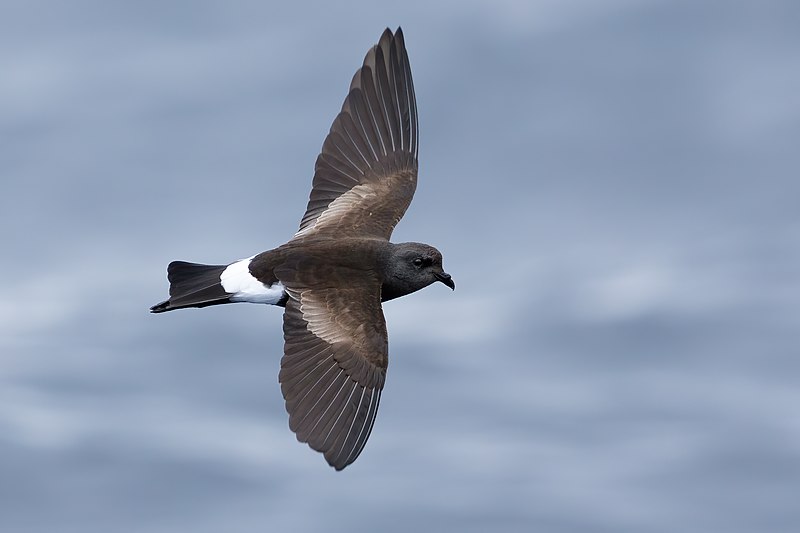
Wilson’s storm petrel is a small seabird of the Oceanitidae family. A circumpolar species, it can be found in both the northern and southern hemispheres during summertime.
Its abundance population is estimated to be around 20 million birds as of 2022, making it one of Earth’s most populous bird species.
This nocturnal creature loves to feed on crustaceans, fish eggs, and larval fishes they catch while flying over open waters near coasts or islands at night.
During daylight hours, Wilson’s Storm Petrel will rest in large groups and form colonies with fellow members for protection against predators like gulls and skuas, which steal their food supplies if given the opportunity.
Scientific classification:
| Kingdom | Animalia |
| Phylum | Chordata |
| Class | Aves |
| Order | Procellariiformes |
| Family | Oceanitidae |
| Genus | Oceanites |
| Species | O. oceanicus |
19. Chinstrap Penguin
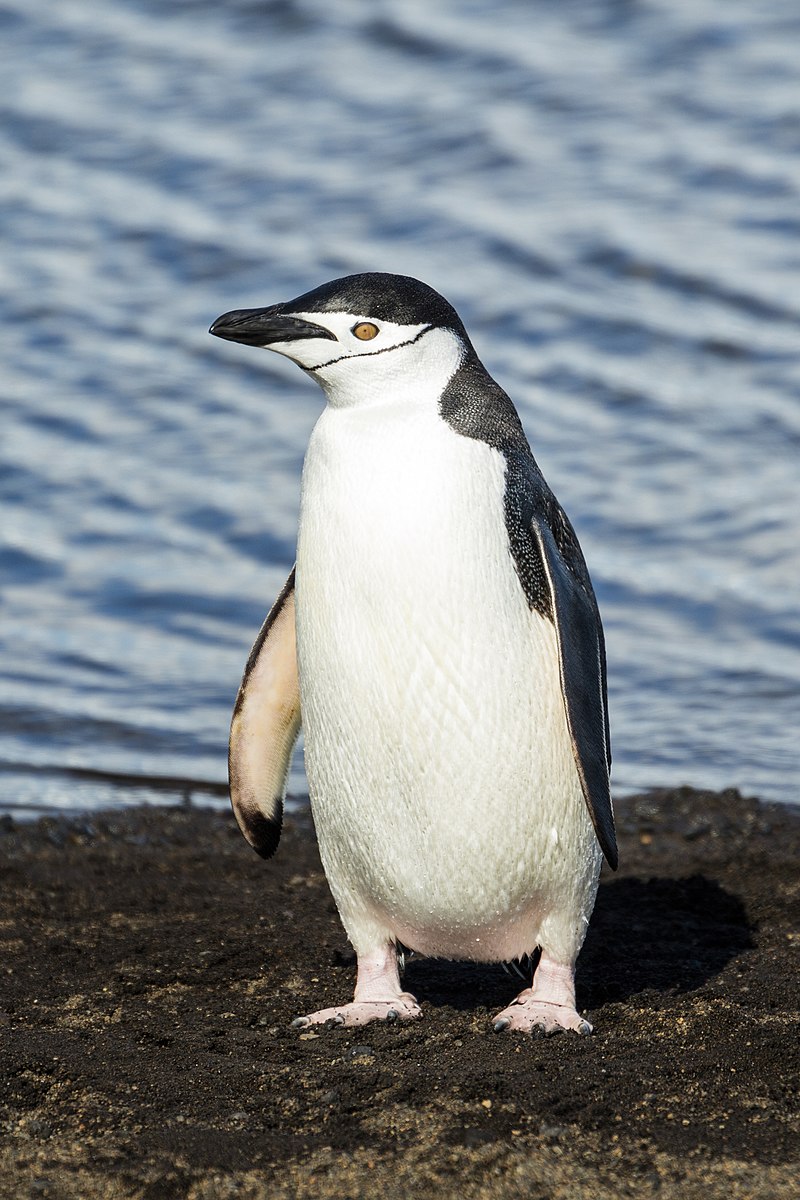
Chinstrap penguins are a fascinating species of birds found in the Southern Pacific and Antarctic Oceans. They have distinct black bands around their heads, making them easy to identify.
These penguins stand up to 70 cm tall, with adults weighing an average of 3-4 kg. Their diet mostly consists of krill, shrimp, and small fish, which they catch while swimming underwater or scavenging for food on land.
Chinstraps are very social animals that form large colonies when breeding – during this time, males will fight each other over territory rights.
As well as being fun to watch, these little fellows can also be quite noisy too.
All in all, the chinstrap penguin is one amazing bird that deserves our admiration and respect – it’s no wonder why many people across the globe so believe them.
Scientific classification:
| Kingdom | Animalia |
| Phylum | Chordata |
| Class | Aves |
| Order | Sphenisciformes |
| Family | Spheniscidae |
| Genus | Pygoscelis |
| Species | P. antarcticus |
20. Gentoo Penguin
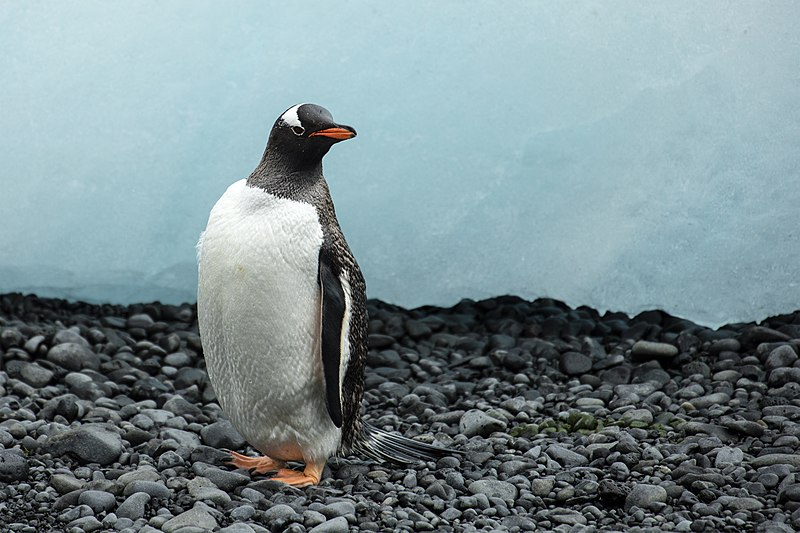
Gentoo penguins are an iconic species of birds found in the Falkland Islands. They have distinctive black and white plumage, bright orange beaks, and feet.
The Gentoo is one of three closely related species—the Adélie Penguin (P. adeliae) and chinstrap penguin (P. antarcticus)—and they can all be seen co-existing in their natural habitat near open water or on ice shelves around Antarctica, including the South Shetlands, Orkneys, South Georgia islands, Kerguelen Islands and Macquarie Island to name just a few places.
This sociable bird is known for its loud call, which sounds “gentle” and makes other vocalizations, such as honks during courtship displays.
Gentoos prefer to live in large colonies but often nest alone or form small groups when needed.
With climate change increasingly negatively affecting Antarctic habitats these days, it’s more important than ever that we protect this fascinating animal so future generations may enjoy them too.
Scientific classification:
| Kingdom | Animalia |
| Phylum | Chordata |
| Class | Aves |
| Order | Sphenisciformes |
| Family | Spheniscidae |
| Genus | Pygoscelis |
| Species | P. papua |
Also Featured In: Native Birds Of West Falkland, Jason Islands Birds You Didn’t Know
21. Southern Royal Albatross
The Southern Royal Albatross, or Toroa, is an impressive sight. With a wingspan of 3 meters (9.8 feet), it’s one of the world’s two largest species of albatross, alongside its close relative – the Wandering Albatross.
Recent studies have shown that it may even be larger than its cousin when taking mass into account and with similar wingspans.
The bird has grey-brown plumage on its head and body, while they have white underparts plus black tips to their wings, which can easily be recognized from far away.
They are highly social birds who often congregate together before setting off for long journeys; during these trips, they rely heavily on oceanic winds for support and thermal uplift beneath them to stay airborne without expending energy flying themselves.
Scientific classification:
| Kingdom | Animalia |
| Phylum | Chordata |
| Class | Aves |
| Order | Procellariiformes |
| Family | Diomedeidae |
| Genus | Diomedea |
| Species | D. epomophora |
22. Antarctic Prion
The Antarctic Prion is the largest of all prions, a genus of small petrels found in the Southern Ocean.
It was first described by German naturalist Johann Friedrich Gmelin in 1789 as part of an updated edition to Carl Linnaeus’ “Systema Naturae” and placed with other petrels under his Pro genus.
The bird has two distinct morphs – one dark gray-brownish back color and another lighter gray morph that can be spotted during migrations across different parts of Antarctica’s coastlines.
Its diet consists mainly of crustaceans and fish, which it scoops while flying through surface waters on its long wingspan.
While they are often seen alone or in pairs, large groups may also form when feeding near krill concentrations or human settlements such as research stations around Antarctica’s coasts.
Scientific classification:
| Kingdom | Animalia |
| Phylum | Chordata |
| Class | Aves |
| Order | Procellariiformes |
| Family | Procellariidae |
| Genus | Pachyptila |
| Species | P. desolata |
Also Featured In: Beautiful Birds Found in Central Islands, Birds That Live In Tristan da Cunha
23. White-Chinned Petrel
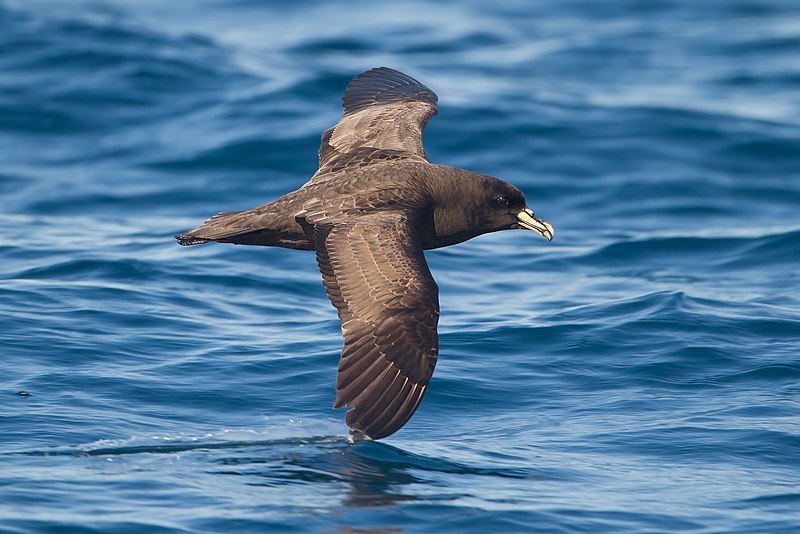
The White-chinned Petrel is a large seabird belonging to the Procellariidae family. It can be found in oceans around the Southern Hemisphere, ranging from Australia to Peru and Namibia.
These birds breed colonially on scattered islands, sometimes called Cape hens or Shoemakers.
Their unique white chins distinguish them from other petrels, such as their former Spectacled Petrel species.
Their wingspan averages about 115 cm across and travel up to 4400 km during migration season.
The White-chinned Petrel feeds mainly on small fish, squid, and zooplankton; it dives into the ocean for its prey using its strong webbed feet.
This species has an impressive lifespan of more than 35 years – making these majestic creatures some of our oldest avian companions.
Scientific classification:
| Kingdom | Animalia |
| Phylum | Chordata |
| Class | Aves |
| Order | Procellariiformes |
| Family | Procellariidae |
| Genus | Procellaria |
| Species | P. aequinoctialis |
Also Featured In: Passage Islands Birds You Should Know, Birds That Live around Southeast Island
24. Slender-Billed Prion
The Slender-billed prion is a species of seabird found in the southern oceans. It was formally described and named by Australian ornithologist Gregory Mathews in 1912 under its binomial name, Heteroprion belcheri, before being placed with other prions in the genus Pachyptila.
This unique bird has slender bills adapted for filtering food from seawater and a long wingspan, which helps them soar over large distances when migrating or searching for prey.
They mostly feed on small fish, squid, crustaceans, and jellyfish but have also been known to eat carrion if necessary.
The Slender-billed Prion’s feathers are typically dark greyish brown above and white below, perfectly blending into their natural oceanic environment.
Scientific classification:
| Kingdom | Animalia |
| Phylum | Chordata |
| Class | Aves |
| Order | Procellariiformes |
| Family | Procellariidae |
| Genus | Pachyptila |
| Species | P. belcheri |
25. Arctic Tern
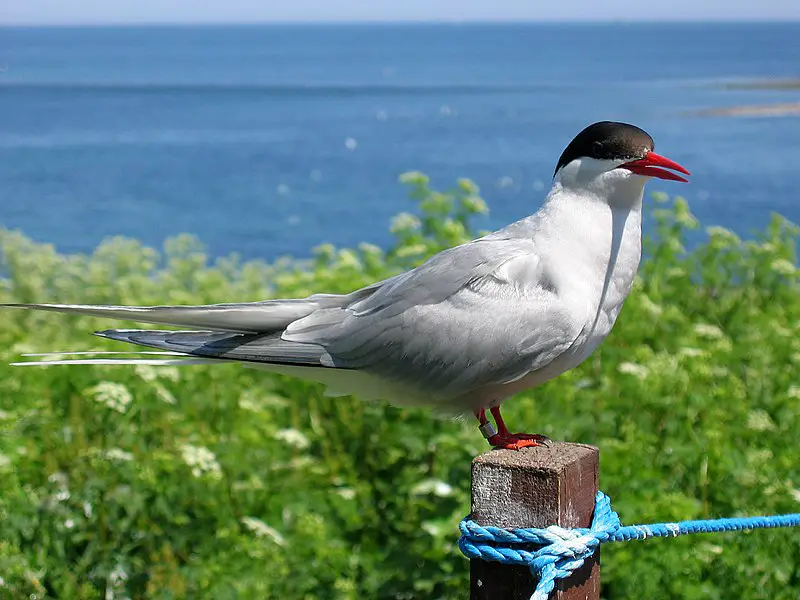
The Arctic tern is an incredible bird with remarkable migratory behavior.
It breeds in the northern regions of Europe, Asia, and North America during summer before migrating along a convoluted route to reach the Antarctic for winter.
This species has adapted extremely well to its environment – it can fly long distances while navigating easily, thanks to its excellent eyesight.
Furthermore, they can survive in temperatures as low as -40 degrees Celsius.
The Arctic Tern is also known for being one of the longest-living birds on Earth; some have been recorded living up to 30 years old.
Scientific classification:
| Kingdom | Animalia |
| Phylum | Chordata |
| Class | Aves |
| Order | Charadriiformes |
| Family | Laridae |
| Genus | Sterna |
| Species | S. paradisaea |
26. Light-Mantled Albatross
The Light-mantled Albatross is a small seabird found in the genus Phoebetria. It has a grey mantle and sooty feathers, which gives it its name.
They are usually seen skimming close to the ocean’s surface, occasionally taking short flights over long distances.
This bird can fly near offshore islands or along coastlines around parts of South America, New Zealand, and Australia’s southern coasts.
The diet mostly consists of squid and fish they catch while gliding above water surfaces.
Their breeding season begins in late August when pairs build nests on slopes located within remote areas with dense vegetation cover like grasslands or shrubbery patches that protect them from predators for their young ones.
Fledging takes place after three months since hatching occurs during the November-December period when winds become stronger, making takeoff easier for chicks upon maturity as adults reach up about 75cm in length with wingspans more than 170 cm wide.
Scientific classification:
| Kingdom | Animalia |
| Phylum | Chordata |
| Class | Aves |
| Order | Procellariiformes |
| Family | Diomedeidae |
| Genus | Phoebetria |
| Species | P. palpebrata |
27. Blue Petrel
The Blue Petrel is a small seabird of the Procellariidae family, found in the Southern Ocean. It is easily distinguished by its blue plumage and short forked tail.
The only species in its genus, Halobaena, has close genetic ties to Prions. Breeding mainly near the Antarctic Convergence zone at various isolated island sites, this bird was first described in 1777 by German naturalist Peter Simon Pallas.
Its diet consists mostly of krill along with squid and fish, which they plunge-dive into ocean waters to catch their prey before returning to nest on land or cliffside burrows where two eggs are laid each year.
They have adapted well over time thanks to their unique traits such as long wingspan enabling them travel far distances while being able to store food reserves during days without feeding opportunities due migration patterns across vast oceans.
Scientific classification:
| Kingdom | Animalia |
| Phylum | Chordata |
| Class | Aves |
| Order | Procellariiformes |
| Family | Procellariidae |
| Genus | Halobaena Bonaparte, 1856 |
| Species | H. caerulea |
28. Diving Petrel
Diving petrels are small seabirds belonging to the family Procellariidae. These birds can be found only in the southern hemisphere and have four very similar species, distinguished by slight differences in their plumage coloration, habitat preference, and bill construction.
They typically inhabit coastal regions near cliffs or rocky shores where they feed upon fish and marine invertebrates using a diving technique that requires them to plunge into deep water while flap-dipping underwater for food.
Diving petrels usually breed on offshore islands during summer, laying one egg per season, which both parents incubate until hatching takes place after about five weeks of development.
Despite being quite adaptable to changing environments, these birds remain vulnerable due to threats like predation from larger sea creatures like seals.
Whales and destruction caused by human activities like fishing nets or oil spills often result in the death of adult individuals or chicks before fledging has taken place successfully.
Scientific classification:
| Kingdom | Animalia |
| Phylum | Chordata |
| Class | Aves |
| Order | Procellariiformes |
| Family | Procellariidae |
| Genus | Pelecanoides Lacépède, 1799 |
29. Southern Rockhopper Penguin
The Southern rockhopper penguin is a species of rockhopper known for its distinct yellow crest. It lives in the subantarctic waters of the western Pacific and Indian Oceans and around the southern coasts of South America.
First described by English naturalist George Edwards in 1743, this medium-sized seabird has black upperparts that contrast against white underparts and face patches. They have very short red bills with orange eyespots on each side.
The birds are highly social creatures who form large colonies near coastal cliffs to raise their young chicks together during the breeding season.
In winter, they move offshore onto pack ice, feeding mainly on small fish such as anchovies and squid.
Despite being endangered due to habitat destruction, these remarkable animals thrive today, thanks largely to conservation efforts worldwide.
Scientific classification:
| Kingdom | Animalia |
| Phylum | Chordata |
| Class | Aves |
| Order | Sphenisciformes |
| Family | Spheniscidae |
| Genus | Eudyptes |
| Species | E. chrysocome |
30. Black-Bellied Storm Petrel
The Black-bellied Storm Petrel is a species of seabird belonging to the Oceanitidae family. It can be found in Antarctica, Argentina, Australia, Bouvet Island, and many other South American and African countries.
These birds are mainly dark brown with white bellies with black markings. They feed primarily on small fish but take crustaceans such as krill or squid when available.
During the breeding season, they form colonies along rocky coasts where they lay one egg per year, which hatch after about 40 days of incubation by both parents.
The fledglings stay for around two weeks before flying for the open seas. This oceanic bird has an impressive range, making it quite a common sight near coastlines worldwide.
Scientific classification:
| Kingdom | Animalia |
| Phylum | Chordata |
| Class | Aves |
| Order | Procellariiformes |
| Family | Oceanitidae |
| Genus | Fregetta |
| Species | F. tropica |
Also Featured In: Black Birds in New Zealand,
31. Fairy Prion
The Fairy Prion is a small seabird in low subantarctic and subtropic seas. It has blue-grey upperparts, a prominent dark “M” marking, and white underside feathers.
The male and female of this species look identical. This bird was first formally described by German naturalist Heinrich Kuhl 1820 under the binomial Procellaria torture.
They are an important part of their local ecosystems and have been studied for years to understand more about them and how they interact with other organisms.
Scientific classification:
| Kingdom | Animalia |
| Phylum | Chordata |
| Class | Aves |
| Order | Procellariiformes |
| Family | Procellariidae |
| Genus | Pachyptila |
| Species | P. turtur |
32. Northern Giant Petrel
The Northern Giant Petrel is a large seabird of the southern oceans and belongs to the Macronectes family. It has a broad distribution, overlapping with its cousin -the Southern Giant Petrel- but slightly northward.
First described in 1912 by Australian ornithologist Gregory Mathews as a subspecies of the Southern Giant Petrel, it reaches up to 75 cm long and weighs 3 kg on average.
Its plumage is dark grey above while white below, having black bill tipped with yellow or pink color along an orange line running from base to tip; its feet are also bright yellowish-orange in hue.
This species feeds mainly on fish and squid near coastal waters or scavenges carcasses farther away out at sea during winter when food sources become scarce closer inland.
Scientific classification:
| Kingdom | Animalia |
| Phylum | Chordata |
| Class | Aves |
| Order | Procellariiformes |
| Family | Procellariidae |
| Genus | Macronectes |
| Species | M. halli |
Also Featured In: Birds that Live in Gold Coasts,
33. Broad-Billed Prion
The Broad-billed Prion is an impressive seabird with a wingspan of up to 28 inches. White underparts contrast its grey upperparts, and both sexes look alike.
It inhabits the southeast Atlantic Ocean, near the Antarctic Convergence to New Zealand.
They breed mainly on Tristan da Cunha and Gough Islands in the South Atlantic and South Pacific areas, such as Macquarie Island, Chatham Islands, Auckland Islands, etc.
During the breeding season, they build their nests out of vegetation or mud burrows dug into cliffsides or slopes.
These birds eat crustaceans and small fish, which they catch while flying low over surface water at night along coastlines.
Their population numbers have been decreasing due to marine pollution caused by human activities like fishing trawlers that often discard plastic materials, which can cause entanglement for these birds, leading them towards death unless rescued quickly enough.
Scientific classification:
| Kingdom | Animalia |
| Phylum | Chordata |
| Class | Aves |
| Order | Procellariiformes |
| Family | Procellariidae |
| Genus | Pachyptila |
| Species | P. vittata |
Also Featured In: Gough Island Birds You Should Know,
34. Yellow-Billed Pintail
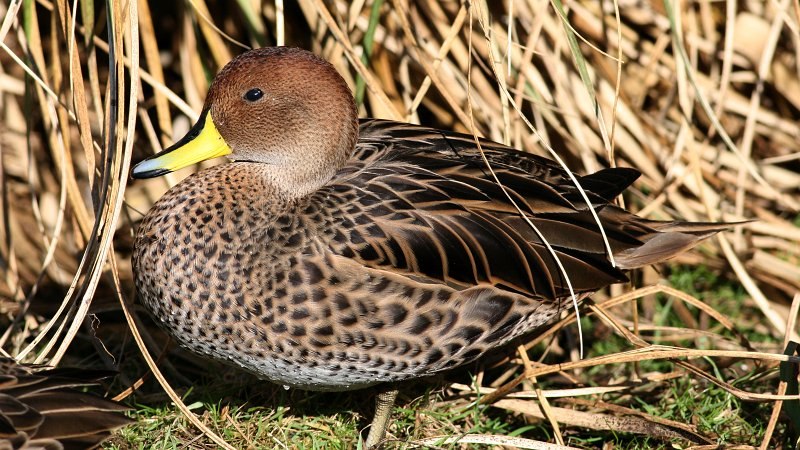
The Yellow-billed Pintail is a South American dabbling duck of the genus Anas, with three described subspecies.
It was formally identified by German naturalist Johann Friedrich Gmelin in 1789 and placed among all ducks, geese, and swans in the same genus.
The species has long legs and necks, which help them to feed on both land and water surfaces easily. Its tail feathers are yellowish white, but its bill is bright yellow, giving it an attractive look.
These birds are mostly found in open wetlands like marshes, ponds, lakes, etc., flying very low over shallow waters while searching for food such as small insects or even lizards & worms.
They breed during summer months near their habitat, making nests out of reeds and grasses before laying 6-9 eggs each time.
Though not considered endangered, conservation efforts must be made to protect these beautiful creatures from disappearing forever.
Scientific classification:
| Kingdom | Animalia |
| Phylum | Chordata |
| Class | Aves |
| Order | Anseriformes |
| Family | Anatidae |
| Genus | Anas |
| Species | A. georgica |
35. Antarctic Shag
The Antarctic shag is a species of cormorant found in the Antarctic. It has many different names, such as imperial cormorant, king cormorant, and blue-eyed shag.
The adult bird stands around 75 to 77 cm tall with a wingspan of 120 cm. Its plumage consists mostly of dark black feathers with white on its face, throat, and belly area, while it has bright blue eyes that can be seen easily from afar.
They feed mainly on small fish but may also eat krill or other crustaceans, depending on availability.
These birds are usually observed by themselves when not breeding but tend to form large colonies during mating season for protection against predators like skuas or leopard seals that prey upon them.
Scientific classification:
| Kingdom | Animalia |
| Phylum | Chordata |
| Class | Aves |
| Order | Suliformes |
| Family | Phalacrocoracidae |
| Genus | Leucocarbo |
| Species | L. bransfieldensis |
36. Grey-Headed Albatross
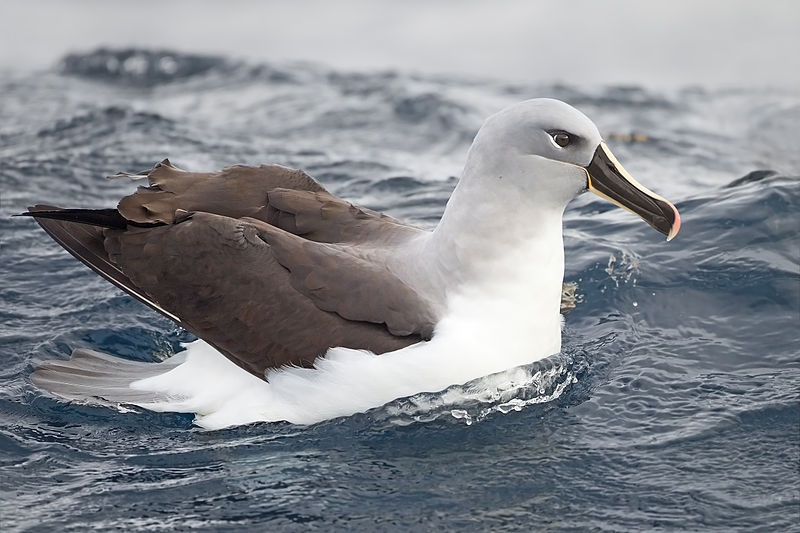
The Grey-headed Albatross is a magnificent seabird from the albatross family. Its name comes from its ash-gray head, throat, and upper neck, making it easily distinguishable from other mollymawks.
This species has an impressive circumpolar distribution and can nest on isolated islands in the Southern Ocean, where they feed at higher latitudes further south than any of their relatives.
They are truly amazing birds that have adapted to survive some of Earth’s most hostile environments.
Through strong wingspan and agile movement, these albatrosses soar easily over vast oceans while searching for food to sustain them during long migrations.
It is no wonder why this species stands out as one of nature’s greatest marvels.
Scientific classification:
| Kingdom | Animalia |
| Phylum | Chordata |
| Class | Aves |
| Order | Procellariiformes |
| Family | Diomedeidae |
| Genus | Thalassarche |
| Species | T. chrysostoma |
37. Sooty Albatross
The Sooty Albatross is a bird species in the albatross family, belonging to the order Procellariiformes. It is also known as Dark-mantled or Black-mantled Albatross.
They breed on sub-Antarctic islands and range at sea across the Southern Ocean from South America to Australia.
The sooty albatross stands out due to its dark brown plumage, which appears almost black against sunlight when flying above the water surface.
These birds feed mainly on fish but have been recorded occasionally eating squid, crustaceans, and carrion.
In terms of behavior, they are social creatures that often forage near fishing boats and congregate around floating objects like buoys or logs with other seabirds looking for food scraps left behind by them.
Overall, the sooty albatross lives an interesting life in the southern hemisphere’s oceans while providing spectacular views during flight.
Scientific classification:
| Kingdom | Animalia |
| Phylum | Chordata |
| Class | Aves |
| Order | Procellariiformes |
| Family | Diomedeidae |
| Genus | Phoebetria |
| Species | P. fusca |
38. Magellanic Penguin
The Magellanic penguin is a beloved South American bird that breeds in coastal Patagonia, including Argentina, Chile, and the Falkland Islands. It migrates to Brazil and Uruguay, occasionally as far north as Espirito Santo.
Vagrants have even been spotted in El Salvador, Antarctica’s Avian Island, and Australia/New Zealand.
This penguin species is perhaps most recognizable for its striking black-and-white plumage – it has an entirely white underbelly with two distinctive stripes across its back, black above and white below.
Additionally, they possess large pinkish feet, which act like paddles when swimming underwater; these birds can swim up to 20 mph.
The Magellanic Penguin typically lives around 15 years, but some may live longer due to their strong social bonds within colonies.
All in all, this majestic creature makes quite the statement both on land or sea – making them a unique addition to our planet’s wildlife population.
Scientific classification:
| Kingdom | Animalia |
| Phylum | Chordata |
| Class | Aves |
| Order | Sphenisciformes |
| Family | Spheniscidae |
| Genus | Spheniscus |
| Species | S. magellanicus |
39. Grey Petrel
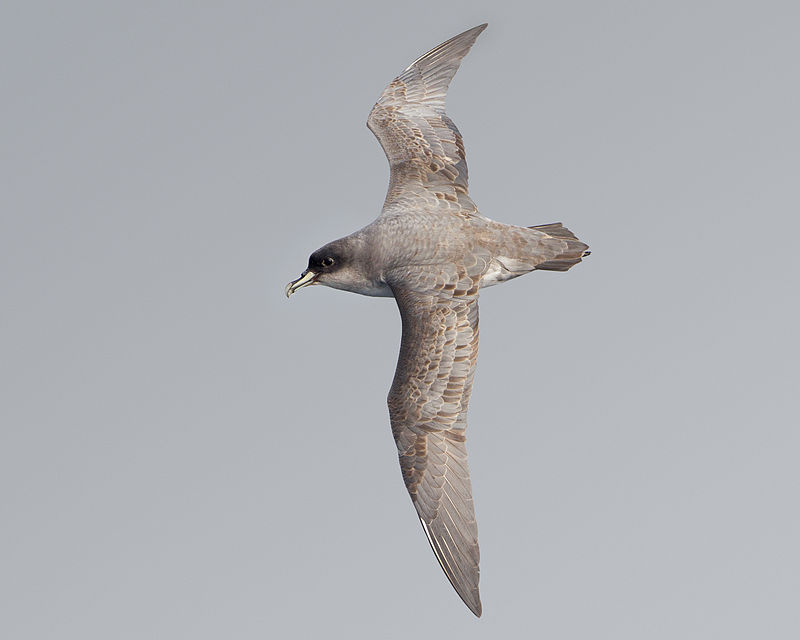
The Grey Petrel is a species of seabird in the Procellariidae family found mainly between 32°S and 58°S.
They are pelagic birds, meaning they spend most of their lives at sea, only returning to shore for breeding season.
The bird was first formally described by German naturalist Johann Friedrich Gmelin in 1789 under its binomial name ‘Procellaria cinerea.’
It is also known as the Brown Petrel, Pediunker, or Grey Shearwater due to its grey plumage and black bill with yellow tip.
Its wingspan can reach up to 68 cm long, and it feeds on small fish, such as sardines or anchovies, which it catches close to the surface of water while flying low over ocean waves.
Scientific classification:
| Kingdom | Animalia |
| Phylum | Chordata |
| Class | Aves |
| Order | Procellariiformes |
| Family | Procellariidae |
| Genus | Procellaria |
| Species | P. cinerea |
40. Pelagornithidae
Pelagornithidae, also known as bony-toothed birds or pseudotooth birds, were a prehistoric seabird family.
Their fossil remains have been discovered in rocks dating back to the Early Paleocene and Pliocene-Pleistocene boundary periods.
These large seabirds are most notable for their tooth-like projections on their beaks, which give them an advantage when preying upon fish and other aquatic animals.
Pelagornithidae could fly long distances over open seas, searching for food and nesting sites due to their wide wingspan of up to 15 feet.
While they may not look like modern-day sea creatures today, these ancient relatives still hold significance in our understanding of evolution.
Scientific classification:
| Kingdom | Animalia |
| Phylum | Chordata |
| Class | Aves |
| Superorder | Galloanserae |
| Clade | Odontoanserae |
| Order | †Odontopterygiformes Howard, 1957 |
| Family | †Pelagornithidae Fürbringer, 1888 |
41. White-Headed Petrel
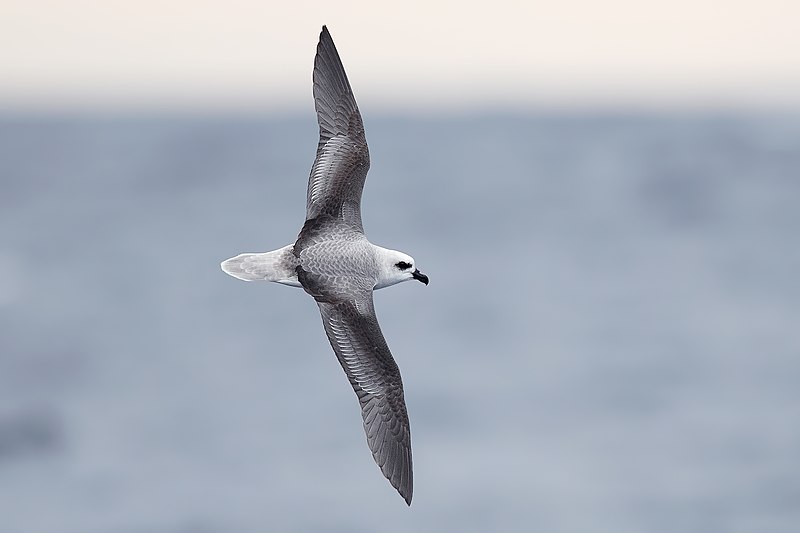
The White-headed Petrel is an adorable seabird from the petrel family Procellariidae. It has a length of about 400 mm (16 in) and can be found on subantarctic islands where it breeds alone or colonially in burrows dug among tussocks and fields.
The diet mainly comprises cephalopods and crustaceans, which they feed upon pelagically.
These birds have white heads with dark eyes surrounded by a circular black patch near their bill; the rest of their body is greyish blue except for their wings, which are black-edged with silver-grey tips.
They use dynamic soaring during migration when flying long distances over water and land while searching for food sources along their route.
In addition, they also rely heavily on winds blowing from east to west across oceans because they can fly further faster while conserving energy simultaneously.
Scientific classification:
| Kingdom | Animalia |
| Phylum | Chordata |
| Class | Aves |
| Order | Procellariiformes |
| Family | Procellariidae |
| Genus | Pterodroma |
| Species | P. lessonii |
42. Brush-Tailed Penguins
Brush-tailed penguins are a genus of three species that inhabit the Antarctic and Subantarctic regions.
They are distinguished from other penguins by their rump legs, giving them an agile swimming ability.
With mitochondrial and nuclear DNA evidence suggesting they split from other species around 38 million years ago, Brush-tailed Penguins predate Adelie Penguin ancestors by about 2 million years.
These birds live in large colonies near shorelines where they feed on krill, small fish or squid to survive cold temperatures as low as -40 °C (- 40°F).
Their black feathers with white bellies provide excellent camouflage while hunting underwater during daylight hours and resting at night on land or sea ice nearby.
All brush-tail species have long life spans, with some living up to 20 years.
Scientific classification:
| Kingdom | Animalia |
| Phylum | Chordata |
| Class | Aves |
| Order | Sphenisciformes |
| Family | Spheniscidae |
| Genus | Pygoscelis Wagler, 1832 |
43. Great-Winged Petrel
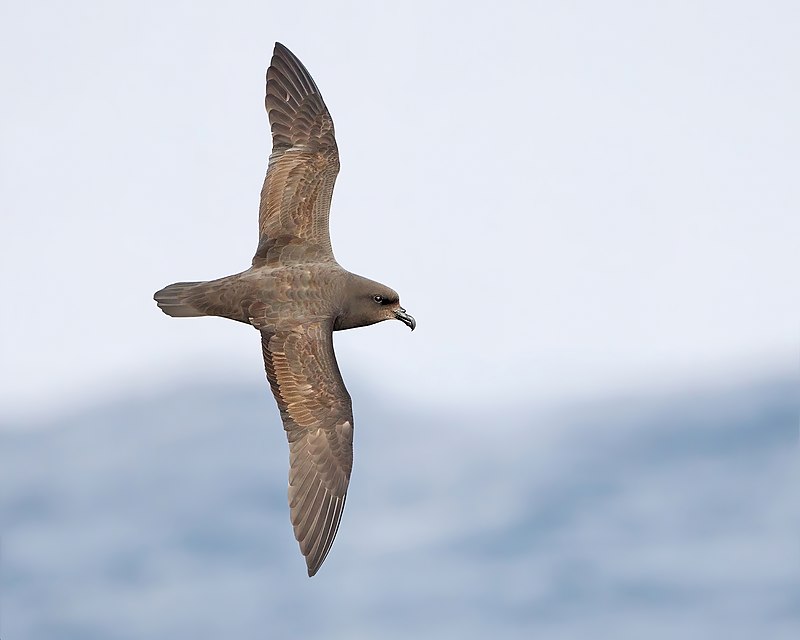
The Great-winged Petrel is a remarkable species of seabird found in the open ocean and coastal areas.
Its scientific name, Pterodroma macroptera, reflects its unique flying abilities; its large wings enable it to soar gracefully over long distances.
This petrel can be identified by its greyish body plumage with white underparts and tail feathers and a distinctive black cap on its head.
It feeds mainly on fish but also consumes squid, crustaceans, and carrion when available. In 2014, genetic research revealed that this bird has two distinct subspecies: Pterodroma m.
macroptera and Pterodroma m gouldi are now classified as separate species – the Grey-faced Petrel (Ptererodoma gouldi).
Both have great conservation value due to their important role in some Pacific Island ecosystems, where they act like scavengers, helping maintain healthy populations of other marine life, such as seals or sea lions.
Scientific classification:
| Kingdom | Animalia |
| Phylum | Chordata |
| Class | Aves |
| Order | Procellariiformes |
| Family | Procellariidae |
| Genus | Pterodroma |
| Species | P. macroptera |
44. Salvin’s Prion
Salvin’s prion is a small seabird belonging to the petrel family Procellariidae. It is one of two species within the genus Pachyptila, also known as ‘prions,’ and can mainly be found in New Zealand, Australia, and South American waters.
Its diet consists mostly of zooplankton, but it has been known to feed on fish eggs or even small fish occasionally.
The bird often travels in flocks along coastlines and feeds close to shore due to its preference for shallow water feeding grounds made available by tides.
With their distinctive white underside contrasted with grey-black upper feathers they are unmistakeable when seen at sea.
Scientific classification:
| Kingdom | Animalia |
| Phylum | Chordata |
| Class | Aves |
| Order | Procellariiformes |
| Family | Procellariidae |
| Genus | Pachyptila |
| Species | P. salvini |
45. Ducks
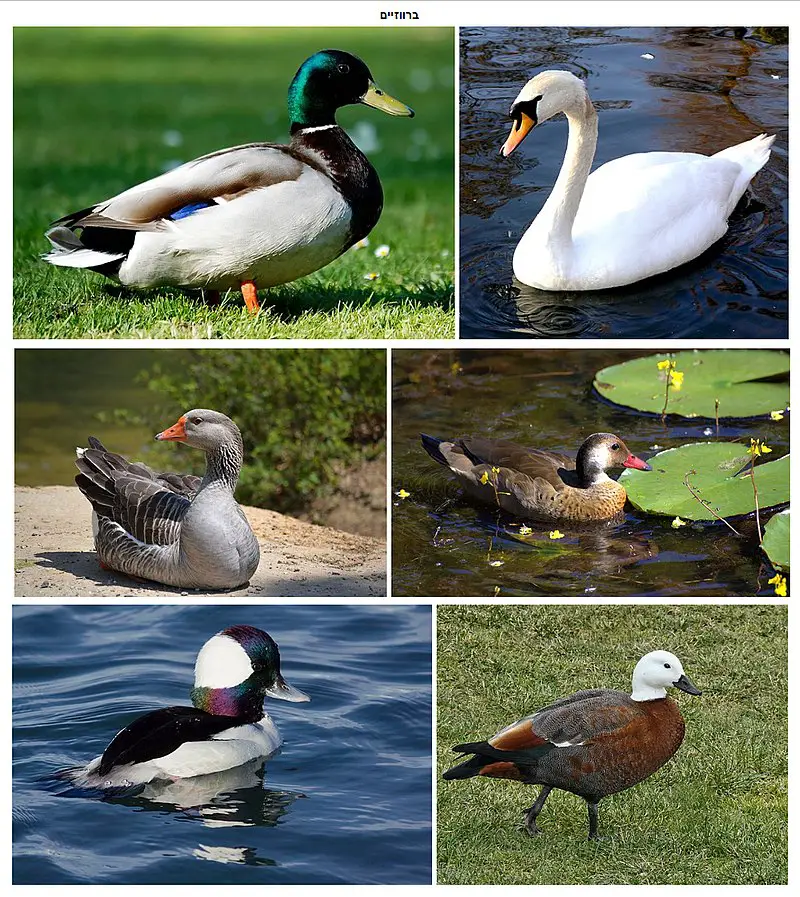
Ducks are water birds belonging to the family of Anatidae. They have a worldwide distribution except for Antarctica and are highly adapted for swimming, floating on water surfaces, or in shallow depths.
Ducks come in various sizes, ranging from small teals to large swans, with around 174 species found across 43 genera.
Their feathers make them waterproof, enabling ducks to stay afloat even in stormy waters, while their webbed feet allow them to swim gracefully underwater.
Ducks feed by filtering food items such as insects, mollusks, and crustaceans through their bills. Still, some also graze on land vegetation like grasses & grains, depending upon the availability of resources at different locations they inhabit.
Scientific classification:
| Kingdom | Animalia |
| Phylum | Chordata |
| Class | Aves |
| Order | Anseriformes |
| Suborder | Anseres |
| Superfamily | Anatoidea |
| Family | Anatidae Leach, 1820 |
46. Soft-Plumaged Petrel

The Soft-plumaged Petrel is a species of seabird found in the Southern Hemisphere. It breeds on islands such as Tristan da Cunha, Gough Island, and Macquarie Island.
Small numbers also breed in Tasmania’s Maatsuyker Island Group. This bird has soft plumage, which helps it blend into its environment at sea or in nesting colonies.
It feeds mainly on fish, squid, and crustaceans while out hunting over the open ocean during daylight hours, then returns to its nest burrow after nightfall with food for its young ones back home.
The petrel nests underground, laying around one egg each year and incubating them until they hatch some months later.
Conservation efforts are helping this species thrive despite threats from introduced predators like cats, rats, and mice that can easily make their way onto these remote islands if not managed properly.
Scientific classification:
| Kingdom | Animalia |
| Phylum | Chordata |
| Class | Aves |
| Order | Procellariiformes |
| Family | Procellariidae |
| Genus | Pterodroma |
| Species | P. mollis |
47. Austral Storm Petrels
Austral Storm Petrels are the smallest seabirds, belonging to the family Oceanitidae and order Procellariiformes.
They have a cosmopolitan distribution across all oceans, with their flight being fluttering and sometimes bat-like in appearance.
These birds feed on planktonic crustaceans and small fish that they pick from the surface while hovering over it.
Their plumage is mostly dark grey or blackish brown above; underparts may be white or mottled gray.
The feet vary between species but usually have pale yellow webs and claws, which help them move easily through water when searching for food.
Austral storm petrels often make nests on remote islands where these birds can breed safely during their nesting season without human disturbances.
Scientific classification:
| Kingdom | Animalia |
| Phylum | Chordata |
| Class | Aves |
| Order | Procellariiformes |
| Family | Oceanitidae Forbes, 1881 |
48. South Georgia Pipit
The South Georgia pipit is an incredibly unique bird, native only to the small archipelago of South Georgia off the Antarctic Peninsula.
It’s the only songbird in Antarctica and one of the few non-seabirds found in this area.
This sparrow-sized bird typically builds its nest from dried grass within tussac grass, laying four eggs yearly.
Its diet consists mainly of small insects and spiders found on beaches or among vegetation.
The population has decreased over time due to various human activities such as harvesting birds for food and destruction caused by invasive species like rats, cats & mice brought onto land by ships.
Conservation efforts are underway to protect these precious creatures as they can provide insight into how other species interact with their environment while helping maintain a balanced ecosystem in this fragile region.
Scientific classification:
| Kingdom | Animalia |
| Phylum | Chordata |
| Class | Aves |
| Order | Passeriformes |
| Family | Motacillidae |
| Genus | Anthus |
| Species | A. antarcticus |
49. Thalassoica
The Antarctic petrel is a dark brown and white boldly marked petrel, found mainly in the Ross and Weddell Seas of Antarctica.
While swimming, it feeds on krill, fish, and small squid but can dive from the surface or air.
Captain James Cook first saw the bird during his second voyage to the South Pacific in 1773.
These birds have strong wings, which allow them to stay aloft for long periods whilst searching for food over vast distances.
They are incredibly social creatures that travel together in large flocks when not breeding season; however, they become very territorial regarding nesting sites, where they will fiercely defend their territory against intruders.
Scientific classification:
| Kingdom | Animalia |
| Phylum | Chordata |
| Class | Aves |
| Order | Procellariiformes |
| Family | Procellariidae |
| Genus | Thalassoica Reichenbach, 1853 |
| Species | T. antarctica |
Conclusion
Despite its harsh and extreme environment, Antarctica boasts a fascinating array of bird species. The continent is home to around 49 distinct bird species, each adapted uniquely to survive in this icy wilderness.
From iconic penguins like the Emperor Penguin to graceful albatrosses and petrels that brave the Southern Ocean’s storms, these birds play crucial roles in the Antarctic ecosystem.
Studying and preserving these avian populations is essential for understanding the complex dynamics of this remote ecosystem and ensuring the conservation of these remarkable species in the face of climate change and other threats.